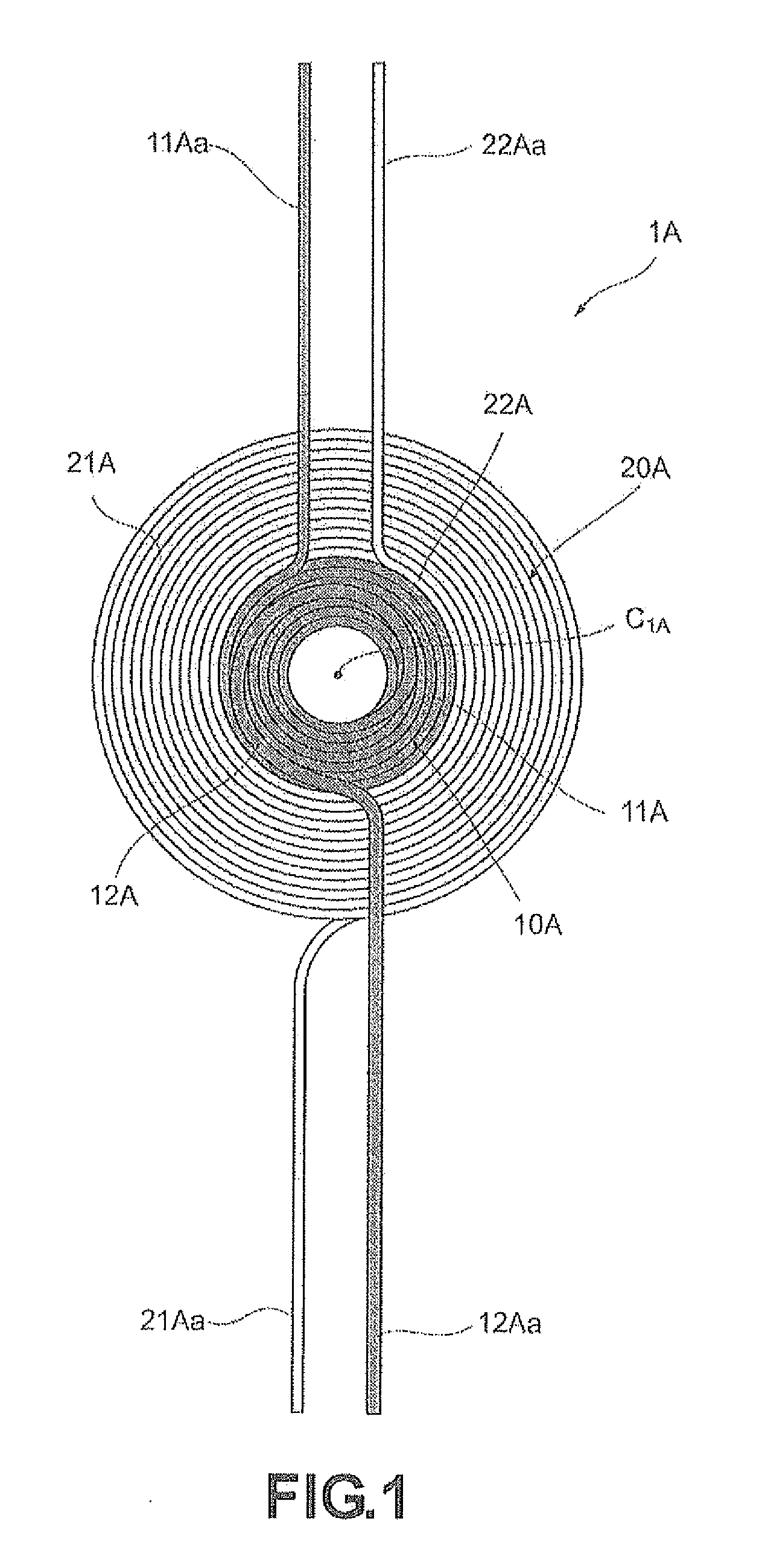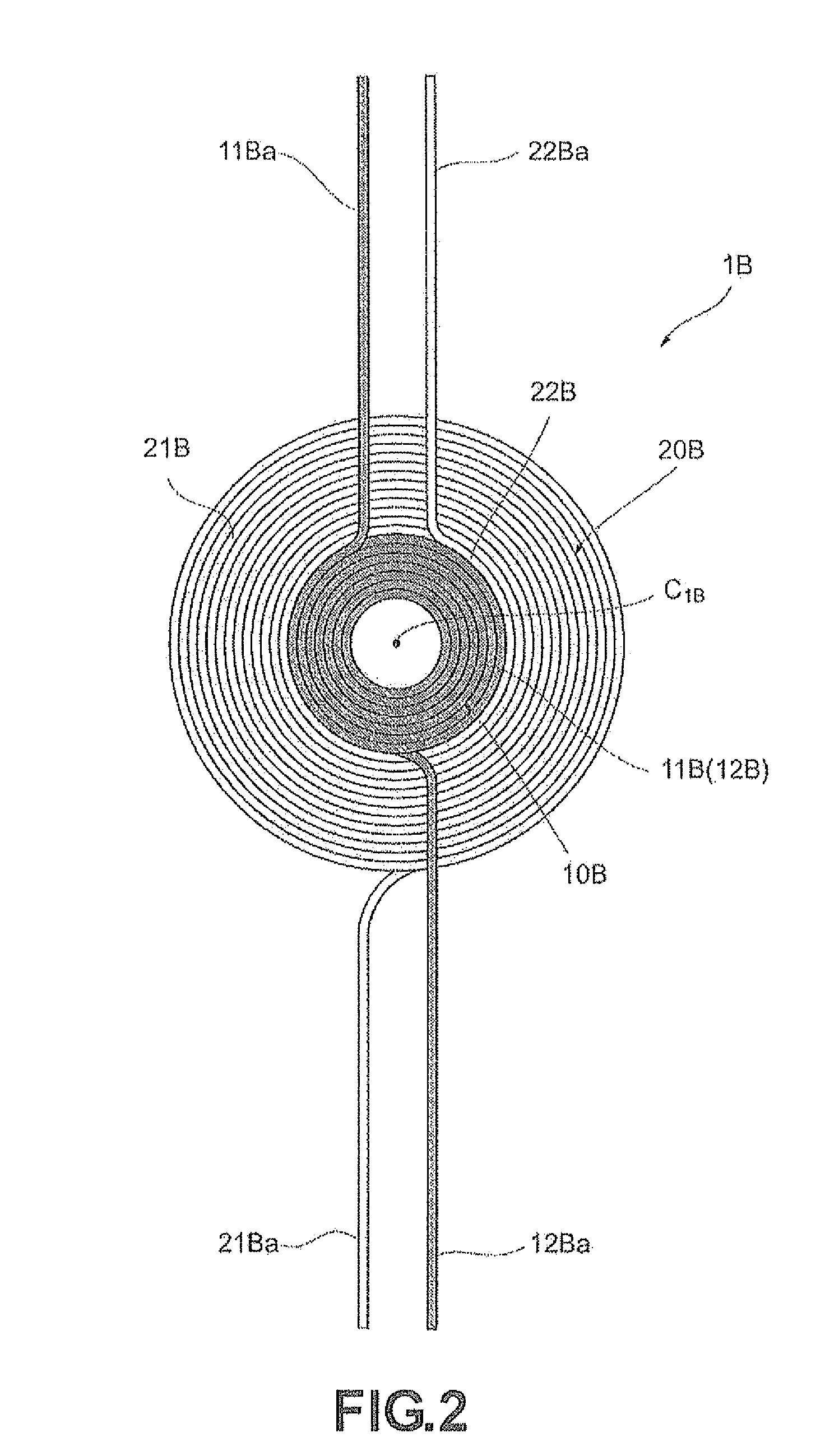Coil
a coil and diametrical direction technology, applied in the field of coils, can solve the problems of increasing the size of the transmitter, the inability to realize the effect of efficient power transmission with respect to a receiver having a coil of a different diameter, and the need for a larger space in the direction of the winding shaft axis, so as to achieve the effect of reducing the thickness, reducing the diametrical direction of one coil, and reducing the thickness
- Summary
- Abstract
- Description
- Claims
- Application Information
AI Technical Summary
Benefits of technology
Problems solved by technology
Method used
Image
Examples
first embodiment
[0041]A coil 1A according to the first embodiment shown in FIG. 1 is a thin-type air-core coil (the air-core portion is round) that can be advantageously used for contactless power transmission. The coil includes a first winding 10A (in the present embodiment, this winding is constituted by a plurality of wires) wound about a winding shaft axis C1A (virtual line perpendicular to the sheet surface) and a second winding 20A (in the present embodiment, this winding is constituted by a plurality of wires) wound coaxially with the first winding 10A so as to be in intimate contact with the outer circumferential portion of the first winding 10A.
[0042]In the first winding 10A and the second winding 20A, each wire of the plurality of wires constituting the windings is the so-called self-fusing wire (for example, a polyurethane-coated copper wire covered on the outer side with a thermoplastic fusible varnish or the like). At the stage of winding with a winding machine (not shown in the figure...
second embodiment
[0060]Similarly to the above-described coil 1A of the first embodiment, a coil 1B of the second embodiment illustrated by FIG. 2 is also a thin-type air-core coil that can be advantageously used for contactless power transmission and includes a first winding 10B (in the present embodiment, this winding is constituted by a plurality of wires) wound about the winding shaft axis C1B and a second winding 20B (in the present embodiment, this winding is constituted by a plurality of wires) wound coaxially with the first winding 10B so as to be in intimate contact with the outer circumferential portion of the first winding 10B.
[0061]The above-mentioned first winding 1013 is wound by the cc winding method. Thus, one side 11B of the winding wire is tightly wound in the clockwise direction, as shown in the FIG. 2, from the inner circumferential side to the outer circumferential side of the first winding 10B, and the other side 1211 of the winding wire is tightly wound (at the same angular spe...
third embodiment
[0064]Similarly to the above-described coil 1A of the first embodiment and coil 1B of the second embodiment, a coil 1C of the third embodiment illustrated by FIG. 3 is also a thin-type air-core coil that can be advantageously used for contactless power transmission and includes a first winding 10C (in the present embodiment, this winding is constituted by a plurality of wires) wound about the winding shaft axis C1C and a second winding 20C (in the present embodiment, this winding is constituted by a plurality of wires) wound coaxially with the first winding 10C so as to be in intimate contact with the outer circumferential portion of the first winding 10C.
[0065]The first winding 10C is wound by the naruto spiral winding method. Thus, one side 11C of the winding wire is tightly wound in the clockwise direction, as shown in the FIG. 3, from the inner circumferential side to the outer circumferential side of the first winding 10C, and the other side 12C of the winding wire is drawn for...
PUM
 Login to View More
Login to View More Abstract
Description
Claims
Application Information
 Login to View More
Login to View More - R&D
- Intellectual Property
- Life Sciences
- Materials
- Tech Scout
- Unparalleled Data Quality
- Higher Quality Content
- 60% Fewer Hallucinations
Browse by: Latest US Patents, China's latest patents, Technical Efficacy Thesaurus, Application Domain, Technology Topic, Popular Technical Reports.
© 2025 PatSnap. All rights reserved.Legal|Privacy policy|Modern Slavery Act Transparency Statement|Sitemap|About US| Contact US: help@patsnap.com



